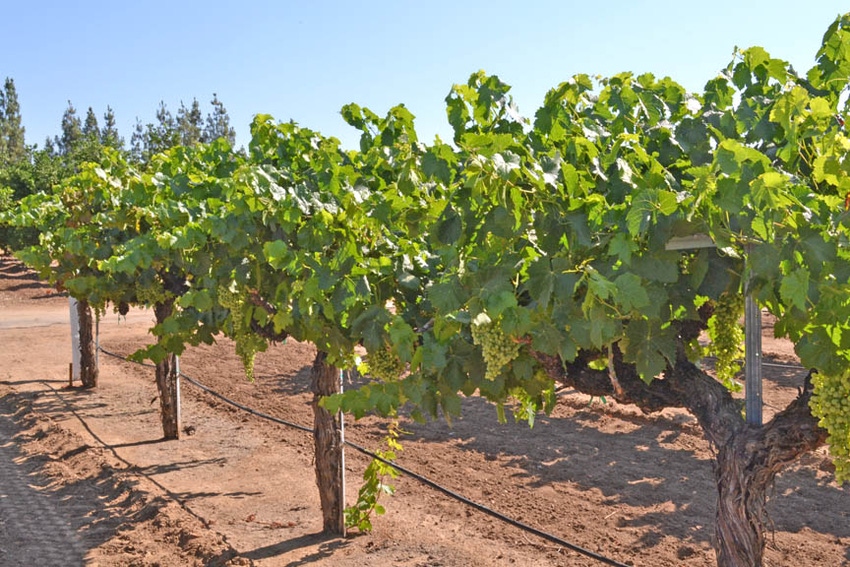January 23, 2014

At a meeting that was brimming with advice on battling raisin pests and diseases, improving yields and looks at the economics for the industry and prospects for new varieties, it was a minutes-long mention of federal assistance that drew perhaps the highest applause level.
The response came to an announcement at the San Joaquin Valley Grape Symposium in Easton that the federal government plans to purchase some $36.4 million of raisins to be distributed to needy families under the Emergency Food Assistance Program.
“That is a big development,” said Glen Goto, CEO of the Raisin Bargaining Association, after the meeting. He said it will mean consumption of some 15,000 tons of raisins at a time when there was “the perception that raisins are in over-supply.”
“Sales are good now, and next year should be good,” Goto said. In 2013, the field price for raisins sold through the association dropped by 12 percent from $1,900 to $1,650. For the Thompson Seedless variety, the price for a ton of grapes sold green to wineries dropped from last year’s $325 to $235.
Larry Blagg, senior vice president the California Raisin Marketing Board in Fresno, shared the good news of the announcement from U.S. Secretary of Agriculture Tom Vilsack, which was made two days before the symposium presented by the University of California.
Vilsack announced that the raisin purchase was included in the purchase of $126.4 million worth of fruit and vegetable produce that also included tart cherries, processed apples, cranberries, fresh tomatoes and wild blueberries.
Those who attended the symposium heard that imports of raisins into the United States have been growing in the past decade and U.S. per capita consumption of the dried grapes has declined since the 1980s.
“Consumers in the United States are paying less for raisins and buying less,” said Annette Levi, an agricultural economist with Fresno State University.
She advised the industry to capitalize on touting the health benefits of raisins, much as those in the nut industries have done.
On a positive note, Levi said exports of U.S.-grown raisins, most of them from California, have grown. She said California raisins account for about a third of world production.
Other speakers at the symposium included:
Craig Ledbetter, with the U.S. Department of Agriculture’s Agricultural Research Service in Parlier, who updated attendees on the raisin grape breeding program in the wake of the retirement of longtime ARS researcher David Ramming.
Those at the symposium were able to sample some raisins from a new dried on the vine variety called Sunpreme, and many showed interest in it. It is in th process of being patented and is not expected to be commercially available this year.
Ledbetter said the staff of ARS researchers dedicated to fruit breeding in the Parlier-Fresno area has been reduced from 10 to three since 1980.
“We’re at a critically short level now,” Ledbetter said.
He said their emphasis now is on finding varieties with three traits: having qualities that suit a natural dried on the vine cultivar, being resistant to powdery mildew and being resistant to Pierce’s Disease.
Fostering Pierce’s resistance alone, Ledbetter said, could put a big dent in the $50 million the industry spends each year to control and monitor the glassy-winged sharpshooter that can spread the disease.
Sonet Van Zyl, assistant professor of viticulture at Fresno State University, talked of studies on rootstocks for raisin grapes.
She said rootstocks having resistance to root knot nematodes, ring nematodes or dagger nematodes and phylloxera – along with high vigor – are most beneficial for the longevity of dried on the vine vineyards.
Sun canes
Among rootstocks commercially available with those qualities are Freedom and 1103 Paulsen.
Matthew Fidelibus, UC Davis extension specialist at UC Kearney Agricultural Center in Parlier, talked of canopy management in dried-on-the-vine vineyards.
He said it is important to prune so as to retain “sun canes” for better bud break rather than retaining shade canes. “Sunlight provides cluster initiation and development and bud survival,” Fidelibus said.
He said that the Selma Pete variety is often planted on Freedom rootstock, which takes up less zinc, and he recommends applying zinc before bloom.
Larry Williams, UC plant pathologist at Kearney Ag Center, talked of nitrogen and potassium requirements of grapevines.
“Nitrogen can be stored and in the vine and can be redistributed,” Williams said, adding that post-harvest nitrogen applications are “not that beneficial.”
Williams said taking petiole and leaf samples to analyze nitrogen availability and use is important, particularly as regulatory controls are put into place on nitrates entering the groundwater supply.
Kent Daane, UC Cooperative Extension specialist at Kearney, discussed the raisin moth, which he termed a “garbage feeder” that thrives in settings where fruit is left to rot.
And he emphasized that fruit on a neighboring farm – perhaps figs or tree fruit – can be important to increasing infestations from the pest.
“The second or third flight periods of the moth are the key,” he said, advising against spraying for the pest in the first flight period when it is not expected to go after the grape in the early growth stages.
Instead, he said, the adults will leave, find another “garbage” source, then return.
He said dried on the vine grapes can risk more damage because ripening fruit is exposed to the moth for a longer time than are tray-dried grapes.
Karen Baumgartner, with ARS Davis, talked of grapevine trunk diseases and surveyed growers on the incidence of those problems and what they’re doing about it.
She recommends taking steps to avoid infection early – before symptoms are observed -- that can lead to esca, eutypa dieback, phomopsis dieback and brotryosphaeria dieback.
Those steps include delaying pruning until February and applying pruning-wound protectants.
She said older infected vineyards benefit little from those steps.
More from Western Farm Press
Almonds vs. grapes a grower’s dilemma
AK-47 rifle was agriculture’s giant loss?
About the Author(s)
You May Also Like




